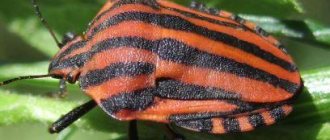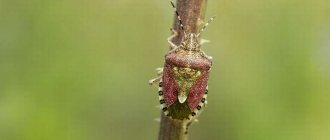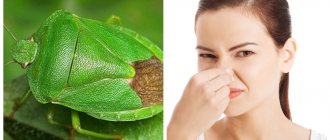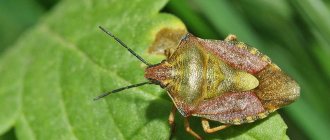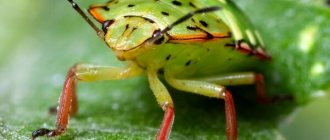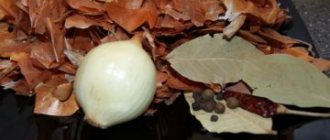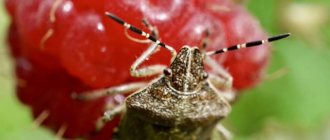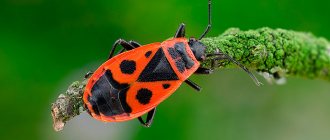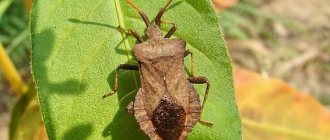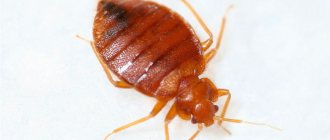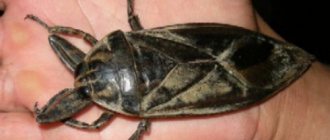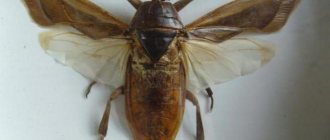Today we’ll talk about one of the most interesting representatives of the huge family of bugs - the harmful turtle. Let's consider why this insect has earned such an unsightly name, and it is not popular, but quite official - scientific. Let’s also put all the dots in those places where it is most needed, because most online sources again give out, to put it mildly, false information, confusing our today’s hero with other insects, and also attach to him those characteristics that they never possessed.
Bug harmful turtle
The bug bug (Eurygaster integrariceps) is a dangerous cereal pest that is most active during the growth and ripening of wheat and other grain crops. This insect can be found on young wheat sprouts or on ears of wheat at the waxing stage.
Although the harmful turtle is primarily an enemy of large agricultural enterprises, the bug often causes damage to vegetable, berry and ornamental crops, so it is useful to know the nuances of pest control.
Development
The eggs are arranged in two, less often in three rows. The female can even lay them on post-harvest foliage or weeds. The harmful turtle is quite prolific and drops from 50 to 400 eggs at a time. The latter have an oval shape and a greenish tint.
As the egg develops, both pattern and color change. On the third day it becomes covered with small dark dots, and on the fourth day large brown oval spots begin to appear. After just a week, the color changes to orange, and by the ninth day the egg acquires a pink tint.
What does a pest bug look like?
Although the insect has a variety of colors: gray, brown-gray, yellow-gray, it differs from other pests in its very dense protective shell, which is covered with patterns - dots or lines - mostly these patterns are whitish, but sometimes they can have a light green or silver tint.
The pronotum of the bug is approximately twice the size of the head, the wings are rounded. This pest bug is an excellent flyer and can cover distances of up to 200 km in search of food!
With the help of a proboscis, the pest penetrates the stalks of wheat and sucks the juice from the capillaries of the plant.
Reproduction of harmful turtle
Life cycle: The adult bug bug undergoes a seasonal diapause that ends in the spring. In winter, it migrates to mountainous areas, and as the weather warms, the pest returns to cereal crop areas, where field populations gradually increase due to ongoing incursions.
Females lay eggs of 5-15 in clusters, mainly on the underside of the smooth leaves of plants. The sex ratio may vary depending on environmental conditions during embryonic development. High temperatures and humidity promote outbreaks of pest populations, while harsh winters negatively affect diapausing adults, reducing reproduction rates.
7-10 days after laying the eggs, larvae appear, which go through 5 stages of development and gradually approach the appearance of an adult.
If you are interested in learning more about this issue, we recommend that you study the photos, which visually show how the larvae differ at different stages of development.
The pest bug poses a great threat to the plants that are its source of nutrition. In winter, stink bugs take up temporary residence under fallen leaves in the forest or on evergreen weeds. Sometimes wheat barns can serve as a place for wintering.
With the onset of spring heat (10-15 degrees), bugs begin to fly and fly in search of early winter crops. As soon as they find a place suitable for feeding and a well-fed life, mass mating of males and females occurs.
Signs of a harmful turtle
Directly for people, this type of bedbug is harmless.
It does not bite, so even if the insect gets into the house, the easiest way is to throw it out the window. If you are unlucky and are still bitten by a bug, a mild allergic reaction may occur after the bite, but this is the maximum of bad things that can happen.
Before you can get rid of pests in your fields and gardens, you must first detect them. Further signs of grain spoilage by the pest bug;
- mass destruction of young shoots occurring in a specific area (if the bugs have not yet colonized the entire field);
- white-headedness or deformation of the original shape of the ear;
- In a ripe ear, you can notice noticeable chipping of the grain, a change in its color, and traces of a bug feast.
List of signs of parasitic activity:
- Inflorescence – panicle changes color, curls and loses shape
- Leaves – yellowed or dry
- Ear - discolored, with empty or shriveled grains, with a dead core
- Stems – discolor and die
- The whole plant is in the drying stage
The harmfulness of the turtle bug
This type of bug is a serious pest of cereal crops such as wheat and barley. In central and western Asia, it causes annual losses of 20-30% of barley and up to 100% of wheat. The entire crop may be destroyed if control measures are not in place.
If some of the damaged plants survive, this can lead to the appearance of “white ears”, a decrease in seed weight and germination rate.
In addition, wheat spoiled by the bug can negatively affect the quality of the flour itself.
After the bug is saturated with the juice of the grain crop, the beans will be completely unsuitable for further use. This is due to the fact that in the saliva of a harmful turtle there is a special enzyme that affects the chemical composition of the food product.
Unfortunately, it is almost impossible to distinguish affected flour from high quality flour when it is dry, since the enzymes lose their quality when dry. But as soon as the process of kneading the dough begins, the substance in the humid environment will begin to work again, and the consistency and color of the product will immediately change.
Benefits and harms
The harmful turtle is a malicious pest of agricultural crops that does not benefit farmers. In the summer, the bug is active, causing significant damage both in the fields and in granaries.
The bug harms cereals throughout the growing season. Its activities lead to:
- death of the central leaf on young stems;
- white-headedness (whitening followed by drying of the ear);
- deformation of the spine of the spikelets;
- damages wheat grains;
- the defectiveness of the grain and its emptiness.
The turtle causes harm in the following way: it pierces the young stem at the base with its proboscis, sucking the juices from the plant. The parasite injects saliva into the green organism, which contains a special enzyme that breaks down carbohydrates. The damaged plant stops growing and dries out.
Punctures of the stem by the bug before heading of cereal crops lead to underdevelopment of the grains. Wheat gluten loses its elasticity under the influence of the saliva of the harmful turtle. This has a bad effect on quality characteristics.
The bug is voracious. Five adult individuals can destroy 50% of the vegetation per 1 m² of planting. The larva of a harmful turtle causes no less harm. It damages the central leaf, and inflorescences on cereals do not form.
Reference. As the air temperature rises, the pest moves en masse into gardens and vegetable gardens. It is often seen on tomatoes, cucumbers, and raspberries.
By feeding on the sap of tomato seedlings, the parasite leads to a decrease in planting yield. The bug does not cause much damage to raspberries. The main danger from the pest's activity is posed to cucumbers.
Why are they dangerous?
The bread bug is a harmful turtle that is not dangerous for humans and pets. You can hold the turtle in your hand without fear of an insect bite. The pest is not able to bite through human skin.
Attention. This type of bedbug does not suck blood. The insect does not carry dangerous diseases.
The harmful turtle is not a predator and does not destroy other insects.
What to do if there is a wound in the house
A harmful turtle sometimes flies into the window by mistake. There is no suitable food for her in the apartment. Grains that are stored in homes in the form of cereals are unsuitable for this pest to eat.
If an insect was found in a residential area, there is no need to take measures to exterminate it. The bug should be released outside.
Larva
The larva emerges from the egg on approximately day 12 and develops from 20 days to two months, passing through five instar stages. The rate of growth largely depends on the environment. Low humidity, frequent precipitation and low temperatures contribute to the mass death of the insect.
There are also external biological factors that influence the development of bedbug colonies. For example, the egg-eater Telepomus dumps its eggs into the clutch of a harmful turtle. The hatched parasites completely eat up the young bug, leaving behind one hollow shell.
Another serious enemy of the turtle is the phasia fly . She lays her offspring directly into the body of the bug, which causes, at a minimum, a delay in the development of the larvae, and at a maximum, their death. Other insects dangerous to turtles include forest ants and ground beetles.
Natural enemies
Natural enemies of the harmful turtle include:
- predatory beetles;
- spiders;
- ants;
- birds.
Other enemies of the bug:
- The greatest danger to the bug is the tachina fly, called the golden phasia, and the Telenomus egg eater.
- Telenomus makes a clutch in the turtle egg, from which the larvae subsequently emerge. They eat the contents of the egg, leaving an empty shell.
- Contact with the gray phasia fly is also detrimental to the bug. She lays eggs on the body of a harmful turtle. The emerging larvae make their way inside the pest, weakening it and depriving it of the ability to reproduce.
- In the wintering area, bedbugs suffer from ground beetles and rove beetles. The species is also threatened by attacks from forest ants.
The harmful turtle is the most dangerous pest of cereal crops, causing significant damage to the agricultural industry. Using preventative measures helps prevent the problem. If infection occurs, it is necessary to immediately treat the crops with preparations with insecticidal properties.
Methods to combat the harmful bug bug
Knowing what measures can be used to control the pest bug is extremely important and even necessary. This will reduce the number of pests and maintain high grain quality.
At the moment there are special preparations, insecticides that can be sprayed on the fields. It is recommended to alternate medications intended to combat harmful turtles to avoid adaptation of adult bedbugs and larvae to the poison.
Chemical methods
The optimal time to apply chemicals (such as organophosphates or pyrethroids) is when 40% of the population consists of second instar larvae.
This prevents the subsequent emergence of adults. Depending on the pest population, spraying may not be necessary.
Biological method
Biological control of harmful turtles is possible. There are several species of spiders that prey on this pest.
The method works when only small populations of first-generation adults are found and when at least 40% first-instar, 50% second-instar, or 70% third-instar larvae are present, no chemical control is required. Entomopathogenic nematodes and various isolates of entomopathogenic fungi destroy pests.
Preventive measures
To preserve the harvest and avoid an increase in the number of insects next season, the fight against bugs must begin with preventive measures.
For this it is recommended:
- Fertilize the soil with mineral complexes containing potassium and phosphorus.
- Harvest as quickly as possible. If it remains in the field for a long time, it may become affected by parasites.
- Destruction of weed plants whose leaves may contain bugs.
- Additional processing of grain, cleaning it from debris and dirt, drying it
Experienced farmers recommend planting grains in areas surrounded by plantations or forest. Trees will become an insurmountable obstacle for this type of insect and will force them to look for another place for their settlement; in addition, “enemies” of turtles live on forest plantations: spiders, birds, ants.
Prevention of occurrence
To identify the pest and prevent it from destroying the crop, monitoring of plants must be carried out at all stages of growth. The turtle can cause harm both during the growth phase and during the flowering period, and during the formation of the fruit ovary. If you notice even single representatives of this species, do not expect that you can do without treating the entire area with insecticides.
Particular attention should be paid to weed control on the site. Female stink bugs readily lay eggs on their leaves and stems.
Since bedbugs overwinter under leaves and in the upper layers of the ground, clearing the area of fallen leaves and planting the soil before frosts would be good preventive measures.
Correct processing technology
Treatment will be effective if it is started at the moment of milky ripeness of the ears. At this time, turtles attack plants most of all. The problem is that pests do not all emerge from hibernation at once. Having destroyed one settlement, after some time another infestation of bedbugs is discovered
Therefore, it is important to process the field with plants several times. Spraying is carried out from the air or by irrigating grain crops locally
The advantage of insecticides is that they remove not only bedbugs, but also many other pests. Safety for the crop will be ensured by compliance with the dosage and proportions of the chemical preparation. Each product differs in composition and method of application.
Aktara drug
After spraying with Aktara, bedbugs stop drinking plant juice within an hour, and after a day they die completely. This is a drug with a wide spectrum of action, but it is sprayed in the morning and evening when there is no wind. It is important to prevent spraying of plants in neighboring fields with other crops. Before planning a bedbug extermination, you need to keep an eye on the weather forecast.
Karate Zeon against pests
An effective suspension called Karate Zeon can eliminate pests in the shortest possible time. The drug has a very fast effect and is safe for bees.
Turtle bugs die almost immediately, and the effect of the insecticide lasts about three weeks. In addition to adults, the chemicals of the drug kill larvae. The aqueous solution cannot be stored; it must be used immediately.
Other insecticides aimed at killing insects include Decis, Eforia, Fastak and others. Such preparations are sprayed from the air and locally, not forgetting about dosages.
Tomato pests in a greenhouse: photos and their treatment
Many pests can operate on tomatoes in a greenhouse and can completely destroy the fruits of a vegetable grower’s labor in a few days. Insects quite often destroy the root system of seedlings and adult plants, gnaw holes in the fruits, causing them to rot and deform. If you do not promptly notice the appearance of insects in the room and do not begin to destroy them, then they will multiply in a very short period and it will not be easy to fight them.
Whitefly is an uninvited guest in many greenhouses. This attractive, delicate-looking moth is a severe pest that causes leaves on bushes to wither, become deformed, and curl. Experienced vegetable growers and farmers know a number of effective methods for dealing with whitefly on tomatoes in a greenhouse.
Root damaged by root-knot nematode
The root-knot nematode is a microscopic worm reaching a length of only 2 mm. It attacks the roots of tomatoes. As a result, the root-knot nematode destroys the cells of the suction zone at the root, which leads to starvation of the tomato. The latter suffer from a lack of moisture and mineral salts, and the plant itself quickly dies.
Prevention and control methods include the following activities:
- Destruction of all plants affected by the nematode.
- Regular loosening of the soil.
- Use of drugs “Dimethoate”, “ROGOR”.
The larva of the nightshade miner leaves winding, chaotic passages on tomatoes. It occurs most often when growing tomatoes in a greenhouse. The pest is introduced by a fly that lays eggs on plants. The danger of leaf miner damage is that the normal production of nutrients in the leaves is disrupted, since photosynthesis in the leaves stops. Affected leaves first turn yellow, wither and fall off. Spraying bushes in a greenhouse with Actellik and Fufanon leads to positive results.
List of chemicals to combat harmful turtles
There are the following types of means to combat turtle bugs:
- insecticides: medicines used against harmful insects;
- acaricides - against ticks;
- fungicides - against diseases;
- herbicides - against weeds.
Insecticides have a chemical and contact effect. They can corrode the skin, clog the spiracles, deprive insects of air flow, penetrate inside and cause disruption of physiological processes. Nymphs are more susceptible to insecticides. The sensitivity of pests also changes throughout the day.
Pesticides against garden bugs:
- To protect fruit and berry crops, solutions, suspensions and emulsions are used.
- Solutions are liquids in which pesticides are completely dissolved in water.
- Suspensions are liquids in which solid powdered pesticides are suspended.
- Emulsions are mixtures in which ground particles of one liquid are also suspended in another.
- Aerosols are produced using special equipment: aerosol generators.
- Solutions, suspensions and emulsions of pesticides prepared for spraying plants are collectively called “working liquid”.
- Organochlorine compounds make it possible to combat many pests on grains, vegetables, industrial crops, as well as pests of trees and shrubs. The release form is oil powders and emulsions, the most common varieties are DDT, HCBD, DDD, HCH, Heptachlor, PCP, PCC and Aldrin.
- Organochlorine insecticides are highly effective in killing most types of pests, but have a significant drawback: they are too toxic and harm both humans and the environment. Now they are trying to replace them with safer means.
- Organophosphorus compounds (OPCs) are orthophosphorus esters, which are characterized by selective effects on insects. The most popular preparations of organophosphorus insecticides are Fufanon, Dichlorvos, Karbofos and Phosalon. The advantages of FOS are their effectiveness in destroying many pests, rapid achievement of results, low consumption, drugs do not accumulate in the human or animal body through accidental contact. The disadvantage is high toxicity to humans and animals. When working with organophosphorus compounds, it is necessary to strictly follow safety rules. Another problem is that insects develop immunity to them over time.
- Pyrethroids are highly effective derivatives of the natural substance pyrethrum; its action is aimed at damaging the nervous system of pests and changing the passage of nerve impulses. The most popular pyrethroids are Fastak, Decis, Fas, Arrivo, Kotrin. Advantages include: selective toxicity that does not affect warm-blooded animals, including humans, the ability to use at low ambient temperatures and long-term retention of the drug in plants. Disadvantages of pyrethroids: they do not destroy pests that hide in hard-to-reach places, and long-term use will cause resistance to the drug in insects.
Separately, I would like to talk about three drugs
Aktara. Insecticidal group of neonicotinoids, effective when sprayed. An hour after application, insects stop feeding and die completely within 24 hours. Aktara is especially effective when there is a large concentration of insects, which makes it possible to quickly and easily destroy most of the population.
Karate Zeon. A pyrethroid insecticide that affects the nervous system of insects and causes their early death (from several hours to a day). The drug is available in the form of a suspension, which prevents the development of resistance to pests.
Ephoria is an effective means of controlling gnawing, sucking and secretly living pests with a wide range of activity. 10–20 minutes after treatment, the bugs stop feeding, and complete death of the insects occurs after 2–4 hours.
Important!
Any insecticide should be handled using a gauze bandage, gloves and a lab coat.
Spraying the medicinal solution can be done from the air or directed locally directly onto the plants.
The above insecticides have a fairly wide spectrum of action and, in addition to the bug, also destroy other plant pests.
Harm from the marbled bug
The insect is especially annoying to winegrowers.
This causes them concern, since damaged berries have a negative impact on the quality of the wine. It is not difficult to detect the presence of a pest on plants. Signs of settlement:
- Specific pungent odor.
- Retardation of growth and development, followed by death.
- Multiple necrosis and tuberosity on the surface of trunks and shoots of fruit and berry crops. A cotton-like substance forms under the bark.
- The berries on the vine do not ripen and fall off.
- The fruits become tasteless.
- The nuts do not ripen fully, being damaged by pests at the milky-wax stage.
- Peppers and tomatoes rot where they are bitten.
- Corn cobs do not develop.
The marbled mite is not dangerous for humans, but it does cause some discomfort. In winter, insects seek refuge from the cold in people's homes. The stench and bites of bedbugs can cause an allergic reaction.
If marble pests get on clothing or bedding, itching and rashes may appear on the skin. Therefore, you need to get rid of them as quickly as possible.
Monitoring populations of the brown marmorated bug makes it possible to predict the appearance of the pest in new territories and take timely protective measures. Since July 1, 2022, the marbled bug has been included in the list of quarantine objects, and by law, land owners are required to monitor and destroy the bug on their territory.
Starting from mid-April, when the marbled bug emerges from winter diapause, the presence of the pest is detected by examining fruit, berry, vegetable and grain plants. During the development of nymphs, they practice the method of shaking samples onto a spread light cloth, and on grain crops, collecting them with an entomological net.
Plautia stali pheromone (MDT) is used to produce a pyramidal trap for the marbled bug, which can be purchased in the USA. This is a 1.2 meter high ground structure, on top of which there is a two-liter container containing a pheromone bait and a killing pesticide strip. The black pyramidal shape attracts bed bugs, apparently because the insects mistake it for a tree trunk.
When the aggregation pheromone of the harlequin bug Murgantia histrionica is added to MDT, the bait acts on the marbled bug even earlier in the season. The combination of these attractants is also used in the production of traps for monitoring the marbled bug.
At the US Department of Agriculture, scientists obtained an aggregation pheromone secreted by males of the marbled bug Halyomorpha halys. Adding this pheromone to MDT enhances the effect of the bait, and in addition, the combined mixture (COMB) shows attractive properties throughout the entire marbled bug season.
The All-Russian Research Institute of Plant Quarantine has begun production of adhesive delta-shaped pheromone traps designed for monitoring and catching the marbled bug. The advantages of this model are simplicity of design and accessibility, since the traps are sold in the Russian Federation and are relatively inexpensive.
Male and female marmorated bugs are equally attracted to light, and light traps are used to monitor populations. From 2004 to 2011, field trials of black light (ultraviolet) light traps were conducted on New Jersey farms. The results showed that such traps are attractive to early-season bedbugs and are useful for monitoring in regions with low population densities.
But traps for marbled bugs are useful not only in agriculture, they also help fight pest infestations in houses and apartments.
Mating period
The genitals of insects of different sexes differ markedly in external characteristics. The male and female have almost the same dimensions. Active mating begins approximately a week after the pests invade the crops.
The females, dropping their eggs, are always on the leaves of plants and do not try to find shelter even when the ambient temperature sharply drops. This period is especially destructive for wheat: white heads and sometimes rot appear. Mating activity subsides towards the beginning of July.
Methods of disposal on specific plants
Although the stink bug prefers cereal crops, you can also encounter it on garden plants.
Horticultural methods for controlling tortoiseshell bugs include early fertilization of winter crops, early sowing of spring crops, and fall plowing of crop residues.
You can’t destroy a bedbug using traditional methods, but you can scare it away!
Methods for controlling the bug on raspberries
You can plant a black cohosh flower (cohosh).
Unfortunately, these preparations only repel bedbugs: the treatment will have to be repeated many times, since the repellent odor quickly disappears.
You can make mustard mash (dilute mustard powder with cool water in a ratio of 1:10) and spray the raspberries.
You can make an infusion from onion peels. Fill the container 1/2 full with onion peels and fill with cold water. After 5 days, the concentrate is ready and can be stored for 1-2 months in a cool, dark place. Apply diluted 1:4 to spray bushes at least 5 times during the season
Bug bug on cabbage
Simply plant onions mixed with cabbage in the same bed or across the bed. Bed bugs cannot stand the smell of onions.
How to get rid of a turtle bug from a tomato
Dissolve 4 teaspoons of garlic powder in a liter of water. Use the resulting solution to treat the tomato leaves. The bug bug will run away from such a smell. But since this is a method of repelling, and not radical extermination, you will have to spray regularly, two or three times a week.
Fighting the turtle bug on wheat
In rare cases, when no method of controlling bedbugs gives the desired effect, owners with small fields release chickens on them. A chicken can kill about a hundred insects within a day.
Habitats
The turtle bug is found in fields, summer cottages and vegetable gardens. It is rare in houses, even old ones. The insect is active in the dry and warm season, and with the onset of autumn it falls into torpor. It is believed that it was brought to Europe from warm tropical countries, where this species has a life cycle of up to 10 months a year.
The turtle bug is found in vegetable gardens and fields.
The pest survived, adapted to the continental climate and now causes enormous damage to grain and vegetable crops.
Its main habitats are steppes and forest-steppes; in cold regions, these flying pests do not have time to produce full-fledged offspring in a short summer.
Life cycle
The larvae develop in the egg from 5 to 10 days, depending on climatic conditions. Small individuals are almost black in color. They go through a long development process. They shed 5 times. After each moult, they increase in size and become more and more similar to adults.
The full development cycle of transformation lasts about 30 days. At the last stage, the nymphs develop genital organs. After mating, the males soon die, and the females begin laying eggs.
On a note!
The turtle bug lays eggs daily, the female's fertility reaches 140-250 eggs, which is why the number of the colony is growing rapidly.
After mating, the seminal fluid enters a special section. It is gradually consumed. One fertilization is enough for the insect to reproduce throughout its life. The last stage nymphs remain overwintering and begin active reproduction in early spring.
Who is called the “stink bug” and how to recognize them?
In general, sedentary insects that do not often use their wings may enter living spaces during migration. The reasons for its onset are unexpected untimely cold snaps, intense heat, a sharp and significant increase in humidity, and fires.
In addition, bedbugs can be carried along with collected gooseberries and raspberries, as well as on clothes or shoes. They can be blown by a gust of wind from nearby trees and bushes into an open window.
The structure of the stink bugs is very similar to that of house bugs. In both species, it has a piercing-sucking function: the proboscis penetrates the food source and sucks out the contents.
Adults have small wings, but this allows them, in extremely rare cases, to fly to a low altitude in order to get to tasty food.
With the onset of winter cold, tree bugs go into hibernation until the weather warms up. As soon as the first blades of grass appear, the insect immediately sets off in search of habitat and food. Most often they can be found on the following plants:
- raspberries;
- gooseberry;
- alder;
- larch.
All shield bugs have some peculiarity - a small rectangular protrusion between the head and stomach, which strikes fear into those who do not know about its harmlessness.
There are several varieties of wood bugs:
The two-toothed stink bug is considered a carnivorous insect. It feeds on other plant pests, which underscores its some usefulness;
Palomena green. In summer it is distinguished by a bright light green color, and in autumn it acquires a brown color;
the northern cruciferous bug has an unusual pattern on the upper body;
The red-legged stink bug has a deep bronze tint. It stands out for its largest body size (can reach 16 mm);
berry shieldweed. The name was given to the insect because of its partiality to various berries, including poisonous ones.
If a shield bug gets inside a home, there are several reasons for this:
- The apartment is warm, but the cold came prematurely. Due to sudden frosts, the beetle crawled through the window, trying to find more comfortable living conditions.
- Flood, forest fire.
- The insect ended up in the apartment along with berries; more often it is brought in raspberries.
Considering that an insect of this family cannot harm a person or even bite, it should therefore be released.
https://youtube.com/watch?v=DJ7WOfcOm_c
Garden stinkers also destroy various plants. In such a situation, they drink raspberry or gooseberry juice.
In the absence of raspberry or gooseberry bushes in the garden or vegetable garden, this parasite damages both other bushes with berries and deciduous trees, as well as a variety of succulent herbs. In addition, the garden representative of hemipterans feeds on cereals or the remains of dead insects.
The daily bedbug diet includes both animal and plant foods. Sometimes this representative of hemipterans damages cereals.
In order not to worry in vain when you see a new insect for you, you can clarify what they look like.
- An adult green wood bug can reach up to 15 mm in length. Body thickness is approximately 3 mm. It has a flat angular shape.
- The color of the bug is juicy green. But it may change depending on the time of year. Since color helps to camouflage, in summer and spring the bug will be green, and with the onset of autumn brown spots will gradually appear on the body to blend in with the fallen leaves.
- These insects also have wings, but rarely use them. On top there is a layer of skin-like hard wings, and under them there are soft membranous wings. And with the help of delicate wings it is very difficult for such a large bug to take off and fly, so they fly only if the goal is a large amount of food, or when they are attacked by other insects or animals.
- They are easily recognized by their characteristic unpleasant odor. Bugs apply their scent wherever they visit. Therefore, it is impossible to eat berries after them. The smell is designed to scare away enemies.
- The wood bug has antennae that are designed to capture the scent of plants.
Notes
- [www.biolib.cz/cz/taxon/id17122/ BioLib] Profil taxonu - čeleď Scutelleridae Leach, 1815 (Czech)
- [fauna.naturkundemuseum-berlin.de/full_results.php?id=12859 Fauna Europaea : Taxon Details] (English). 2013-08-29. Retrieved August 9, 2022.
- ↑ 1234
[bugguide.net/node/view/4874 BugGuide] Family Scutelleridae – Shield-backed Bugs - ↑ 123
[zooex.baikal.ru/hemipteroidea/scutelleridae.htm Zoological excursions around Baikal. Fauna in pictures]
Maliciousness
The pest bug damages grain crops. Overwintered and summer adults feed, as well as larvae from the second instar and older.
Overwintered individuals pierce the stems with their proboscis slightly below the ear bud and suck out the plant juices. A constriction forms at the injection site; the damaged stems do not wither, remaining green, but do not sprout and gradually die off. When injected into the stem of the ear, in the axil of the leaves, above the injection site, white hair appears. When injected below the base, the entire ear turns white.
We invite you to familiarize yourself with pest control of apartments against bedbugs in Moscow, cost, reviews and prices
The greatest damage is caused by older larvae and new generation bugs when feeding on grain. Grains damaged in the early stages of development shrink and end up in waste. Shallow indentations form on grains damaged in the milky-waxy and full ripeness phases. External signs of damage are subtle, but the endosperm in the damaged part turns into a loose, powdery white substance that easily crumbles under mechanical stress. Flour made from damaged grains has low baking qualities.[2]
determined for overwintered bugs:
- On winter wheat, during regrowth and tillering in the spring, if there are more than two individuals per square meter, in a dry spring - one bug per square meter.
- On spring wheat, during the tillering period, - 1.5 bugs per square meter of area, in dry years - 0.5 bugs per square meter.
on winter and spring crops it is established when:
- Larvae of II - III instars during the grain filling period in the amount of two larvae per square meter of area in seed crops and 5 - 6 larvae per square meter in ordinary crops.
- Larvae of III – IV instar during the period of milky ripeness, two larvae per square meter of area.[6]
Reviews
“We used Aktara when we discovered these dangerous insects on plants. The drug is good. The beetles had not yet had time to get used to it, but in a couple of days we got rid of them. After the larvae appeared, they sprayed again. Now the problem is completely resolved. A good insecticide at a decent price, which saved a lot of hassle.”
Andrey, Podolsk
“We noticed the problem too late. Traditional methods were of little use: the turtles disappeared for several days, but then appeared again. But Karate Zeon helped. At first they didn’t believe that results were possible so quickly, but there really wasn’t a trace of the pests left, and the tomatoes were saved. An excellent product for fighting bedbugs in the garden! I recommend."
Marina, Nizhnevartovsk
What is the danger of the Colorado potato beetle on tomatoes?
When the Colorado potato beetle appears on tomatoes, it does a lot of damage.
The danger of such an invasion lies in the following factors:
- favorable conditions contribute to the activation of the insect and its reproduction;
- the appearance of larvae leads to the rapid consumption of greenery;
- the pest successfully adapts to different climatic conditions;
- The beetle is tenacious and voracious.
The parasite is extremely quickly able to adapt to insecticides, developing resistance to these substances, so it is difficult to get rid of the Colorado potato beetle reliably only using folk remedies or other methods. Dealing with him is quite problematic.
Morphology
. A bug with a broadly oval body, 9–13 mm long, 6–7 mm wide.
varies. Most often the covers are light brown, less often gray, light gray and even black.
large, wide, chitinized, covers
. On the top
usually rounded, but sometimes there are individuals with straight
. In the middle
clearly visible
. It is bordered laterally by triangular zygomatic plates. Side edges
rounded and convex.
The genitalia of different-sex individuals differ in external structure. The structure of the male genitalia is an important species characteristic. Secondary sexual characteristics are not designated.[1]
The egg is round, green. Diameter 1 – 1.1 mm. As it develops, it changes color and pattern. On the second - third day it is evenly covered with brown dots, on the third - fourth the light green color is restored, at the same time a dark round spot appears on the lid.
What damage do insects cause?
Of the stink bugs, the species that causes the most harm is Eurygaster integriceps, translated as “harmful turtle.” This species of stink bug feeds on young shoots of cereal crops, can make long flights, winters in forests, flies to fields in the spring and causes serious damage to cereal plantings.
Adult insects and their larvae, feeding on plant sap, use their proboscis to make punctures in the fruits, stems and leaves of the plant; yellowish-whitish spots remain at the puncture site. As a result, the plant withers, grows poorly and withers, damaged young shoots of cereals either die or produce a poor harvest with depleted seeds. Thus, great damage is caused to wheat and rye fields.
Another family of stink bugs, the so-called cruciferous bugs, seriously harm vegetable crops, as they feed on the juice of cabbage, carrots, dill, and rapeseed. These bugs are bright blue-green with metallic highlights and yellow-red stripes or spots.
Berry scale insects cause damage to gardens with berry bushes. These bugs feed on both the juice of leaves and the juice of the berries themselves, leaving an unpleasant odor and having a detrimental effect on crop growth.
Household insect parasites are extremely unpleasant roommates. Have you been bitten by a flea? Read this article and help yourself.
We all know that to protect plantings it is necessary to spray. How to do this correctly, read the link.
Description of the garden bug
The berry shield bug is often found in the garden. People often call it the “stink bug” because it emits a strong, unpleasant odor. They are not capable of harming a person, but at the same time many people are terribly afraid of them. The bright multi-colored color makes it invisible to humans, since the parasite merges with berries or young leaves.
The favorite delicacy of the garden bug is the juice of young plants. As a result of such parasitism, the leaves become covered with brown spots, and the shoots gradually dry out, which can lead to the death of the plant itself.
Summer residents determine the appearance of bedbugs on the site by many signs:
- Cucumber leaves and cabbage leaves are rolled into a tube.
- Small brown spots appear on the leaves.
- Small brown or brightly colored insects appear on young shoots.
- Egg clutches of parasites can be found on the leaves.
- The shoots dry out and die.
You need to start fighting garden bugs as soon as the first signs of infestation appear.
To do this, it is important to be able to distinguish types of parasites from each other, since some individuals can not only destroy plants, but also protect them from aphids, thrips, Colorado potato beetle larvae, etc.
The green bug has an oval body with wide “shoulders” and a small head. All integuments are reliably protected by a dense chitinous shell, consisting of individual scales. The color changes depending on the time of year. If in the spring it has a bright, green shade of grass and young leaves, then during the summer it gradually darkens. By autumn the color becomes yellowish-brown. In this way, the bug provides itself with camouflage and additional protection from predators.
Habitat
The green bug can be found in any corner of Europe where deciduous trees and berry bushes grow. It can live in forests, green lawns and gardens.
What does it eat?
There are a large number of garden pests. Some of them parasitize only on cultivated plants. Here are the types of bugs that appear on tomatoes:
- Green shield. It usually feeds on wild and park plants. However, it happily colonizes garden plots and primarily attacks raspberries.
- Cruciferous beetle. The scientific name of the parasite is northern eurydema. With its color it resembles an ordinary soldier beetle. The objects of their attack are cabbage, radishes, lettuce and radishes.
- Pear bug. This pest affects apple trees, pears, plums, apricots, and cherries. A large number of insects on a tree leads to wilting of leaves and death of fruit.
- Berry shield. An avid enemy of raspberries, currants, and gooseberries. The photo shows an adult representative of this individual.
- Cucumber beetle. This is the smallest representative of this type of insect. The length of its body is no more than 4 mm. Its habitat is the inside of the leaves of cucumber, eggplant, pepper and tomato. Most often inhabits greenhouses.
- Insect "harmful turtle". This pest is very rarely found in the garden. This insect is a pest of cereal fields.
- Horsefly bug. A very common insect in Russia. Its diet includes almost all cultivated plants.
Features of the species, habitat
The bug bug belongs to the family of stink bugs. This species received this name for its appearance, since the body of the insect looks like a small turtle, and the relief and color of the elytra resembles a shell. The adult size varies from 10 to 15 mm in length.
In everyday life, this species is classified as a grain bug. The popular name is due to the gastronomic preferences of the parasite. A photo of the harmful bug is presented below.
Turtle bugs belong to the order Hemiptera and have two pairs of wings. Pests fly well and easily move between food bases.
Parasites show their activity with the onset of stable heat, when the temperature reaches 15 degrees above zero. The sex of the future insect does not play a role in the feeding intensity of the larvae. During this period, overwintered individuals begin to actively eat winter varieties of cereal crops. The tortoiseshell bug is especially common in wheat; it likes young, succulent stems.
What does it eat?
The harmful bug is fixed at the base of the stem, because active growth processes take place there, the leaf structure is loose and juicy. Then it moves higher as the bud rises upward.
The insect makes a puncture in the plant with its sharp proboscis, introduces digestive enzymes that corrode the inside of the stem and cause it to rot. The bug sucks out the decomposed tissues of the plant, and it can no longer bear fruit, since the flow from the root to the ovary is disrupted.
Particular harm is caused to the following crops:
- wheat;
- millet;
- corn;
- oats;
- raspberries;
- tomatoes;
- sweet pepper.
The turtle bug damages wheat.
